Ok, it’s still 2017. Enough of the year left, just, for me to finally detail how I built my 2017 S-Works Tarmac and still feel timely. Like many manufacturers, Specialized reveal new models mid-year. So there are men and women getting about on 2018 Tarmacs right now. But my bike has taken a year to complete to my satisfaction anyway. Here’s what I built:

The finished product. December 2017.
I’d been racing on a heavy old 2012 Specialized Roubaix since 2013. This was my first adult road bike, purchased at the end of 2012. I didn’t know what I was doing and the Roubaix seemed like the best bike for my buck. Back then I’d actually set off to get an alloy road bike, still very unsure of my riding, and came home with what seemed like amazing technology. But I didn’t know what I was doing and soon felt I’d bought a bike that was fractionally too big for me. By the time I was racing I realised many riders of equivalent ability were on better bikes with the competitive advantage that entailed.
But good bikes are expensive. Plans to upgrade moved slowly, at least giving me time to consider my options. When I got beaten into second place in the final stretches of the 2016 Mt Baw Baw road race, by a guy on a famously light Trek Emonda SLR, the impetus to get going received a big push.

Mt Baw Baw. The last mountain race for my Roubaix. Photo from video: David Tennant.
The S-Works Tarmac had always been in my mind as a potential upgrade; Specialized were the first brand whose line up I came to know. But I really researched widely. Anyone who rode with me in the four years before my mind was made up was probably badgered for details about their bike. I was turned off the Trek Emonda by DJ Connel’s blog post stating that bike’s weight savings are matched by poor aerodynamics. I considered Swift-Carbon but a friend convinced me their frames lacked a certain aesthetic appeal. At one point I was keen on a Ridley Helium but I couldn’t get a frame, only the full bike (this was also a strike against the Emonda).
In fact, the ease with which Specialized dealers can sell frames gives them a huge advantage in the upgrade market over stores which can only sell complete bikes. I knew I’d be swapping my Quarq power meter between the Roubaix and the upgrade (the Roubaix was to remain an active but dedicated ‘B’ bike). I’d also bought a whole SRAM Red groupset cheaply and had no plan to upgrade my Fulcrum Zero race wheels.
The Tarmac, it has to be said, also has an incredible record. Perhaps the most dominant race bike of recent years. I suppose the fact Specialized sponsors multiple teams has helped them achieve that record. But still, when you get a Tarmac there’s no doubt you have a machine with famously winning potential. Sure it’s the engine that counts etc. etc. But it doesn’t do any harm as a club racer to know your bike’s top-level pedigree is sound! A fascinating blog post at Sicycle demonstrates Specialized’s winning ascendancy over the past 20 years, and most of those wins would have been on Tarmacs.
I really love the geometry of the Tarmac – just classic enough, just contemporary enough, at least for the 2017 model and preceding years. The Emonda is close in this respect, but the downtube is too big; the Helium is close but the seat stays a so thin they look fragile; even a Giant TCR is close in profile but then the tubing gets boxy up close. The Tarmac is just right.
Of course, Specialized then went and dropped the seat stays for the 2018 model after denying it made an aerodynamic difference in their ‘win’ tunnel for years. With this move I think they threw away a beautiful geometry. I guess the company made their bed with the ‘aero is everything’ mantra, and now they have to lie in it.

2017 model (left) vs 2018 redesign with dropped seat stays.
Aerodynamic concern had influenced me away from the Emonda, but I’m dubious about the gains made by this radical aesthetic change. To me, the 2017 year model Tarmac is the epitome of the bike’s evolution.
So after deciding the new bike was to be an S-Works Tarmac, and confirming I was ideally suited to a 54cm frame, unlike the 56cm frame I’d been stretching myself over for four years, I saved a stack of cash and spent it all!
Initial Build
As stated, I had some parts ready to go:
- 2015 Fulcrum Zero wheelset
- SRAM Red 22 groupset
- Quark power meter / crankset with 50/34 compact Sram Red chain rings and Ultegra Pedals.
My Quark is a GXP crankset: the BBs on the Roubaix and my TT bike are 68mm threaded. The Tarmac has a PF30 BB, but this was easily worked around with some plug-in adapter cups.
On to this set up I added a 128mm Bontrager Paradigm XXX Saddle. I had previously used a 130mm Specialized Toupe on my Roubaix but switched to the Bontrager after that saddle was destroyed in my 2015 crash. It turned out to be lighter and more comfortable:
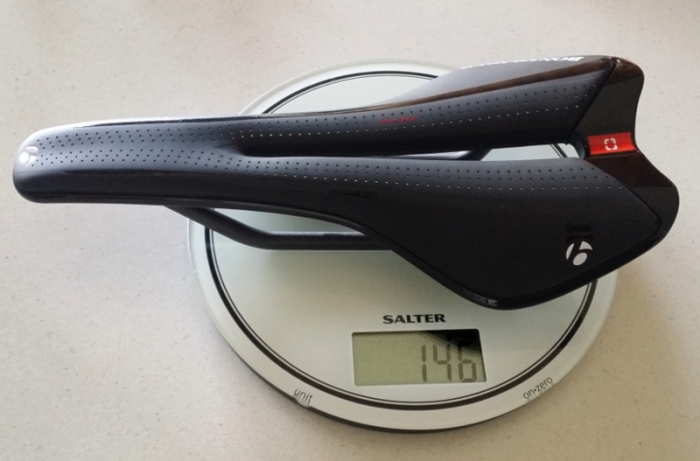
128mm Bontrager Paradigm XXX Saddle
I had a 110mm S-works stem on order, but used a place holder while I waited. The bars were briefly a stop-gap alloy model before I received my S-Works Carbon Shallow Drop:
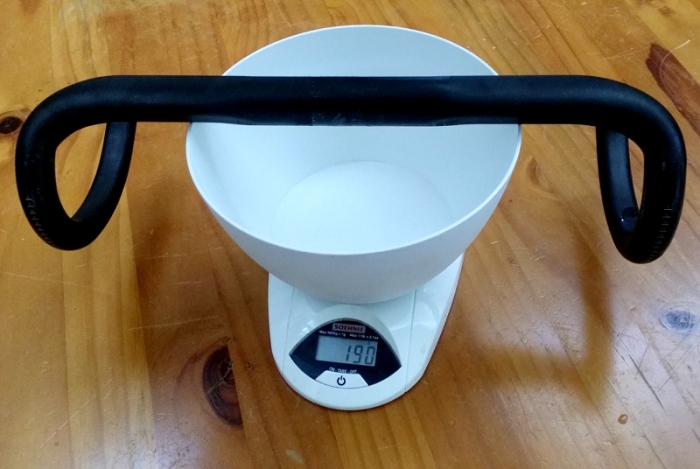
190g
I wrapped the bars in Lizard Skin DSP Race 1.8mm tape. After using this tape everything else seems absurdly plush.
My Garmin mount is the little plastic SRAM one.

19g
The wheels were shod in S-Works Turbo Cotton clinchers, 24mm front and 26mm back (Specialized say this is their fasted combination).

24mm 209g (l) 26mm 238g (r)
Tubes were the scarily fragile 50g latex tubes from Vredestein (I have a photo comparing various tube weights later in the post).
The skewers were amongst the lightest in the world – the value for money Planet X Ultralight Ti Sticks:

1 gram lighter than advertised! 20g front, 23g rear.
If you’re going to have an expensive bike you may as well have some German carbon bidon holders at 9 grams right?:
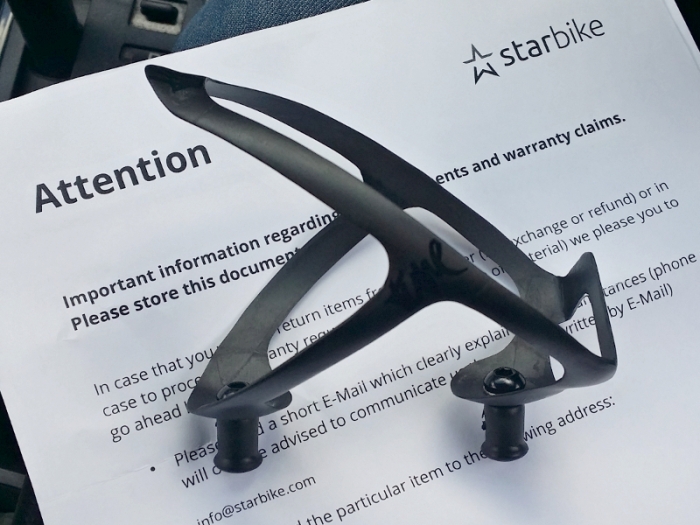
Tune Wasserträger 2.0
The translated English on the Tune website has turned out fantastically weird:
Made of carbon – a servant of the noble blood … “Little cattle also do manure” – with inconspicuous accessories, amazing weight can be saved.
But the pièce de résistance to make this build was the choice of Alligator iLink compressionless cables. I’d seen these aluminium links on Alberto Contador’s Tarmac. They’re half the weight of standard cables and the compressionless actuation means a faster response to shifting and breaking.
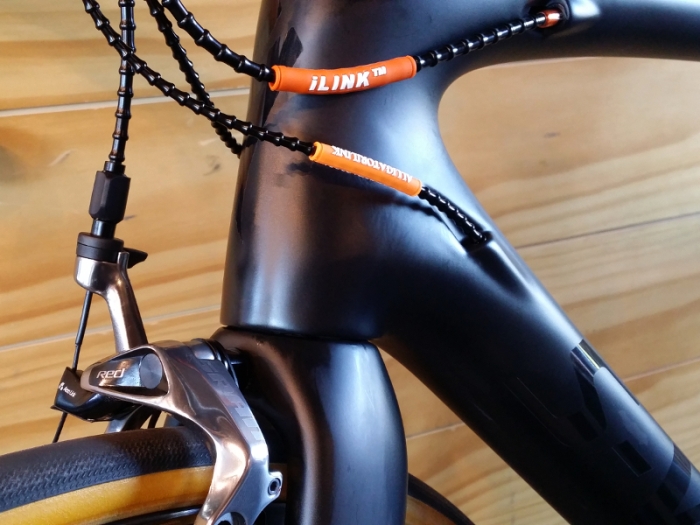
Alligator iLink cables
With the Quarq the bike weighed in under 7kg. Light and legal!
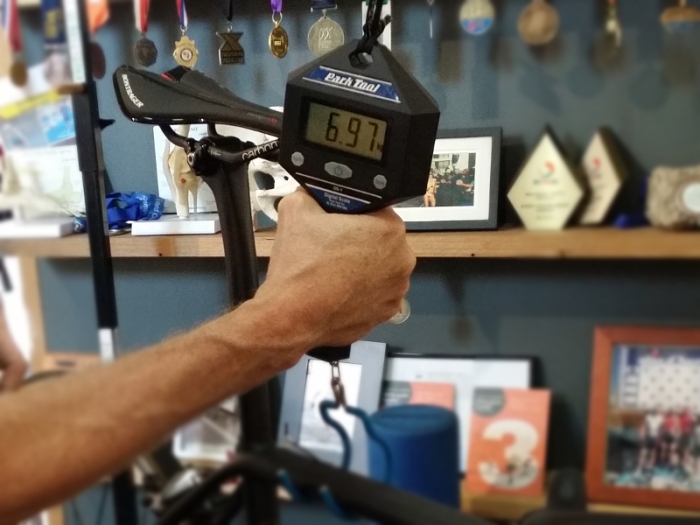
Initial build weight, 6.97kg.
Naming!
Now every bike needs a name … Claire had namer her Amira ‘Molly’ after Molly Jones in the Beatles Ob-La-Di Ob-La-Da, so this bike had to be ‘Desmond’ from the same song. So we could have ‘Desmond and Molly Jones.’ (My Roubaix was belatedly named after the Beatles character Maxwell Edison, after it caused me to hit my head!).
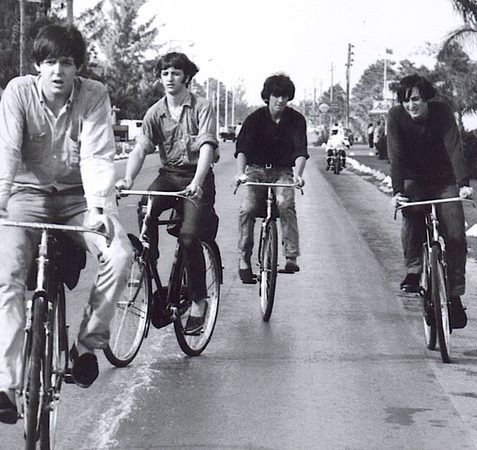
“Happy ever after in the market place …”
Two weeks after the initial build was done I’d won the KOM classification at the Tour of Bright in Masters C. The bike was paying for itself quickly.
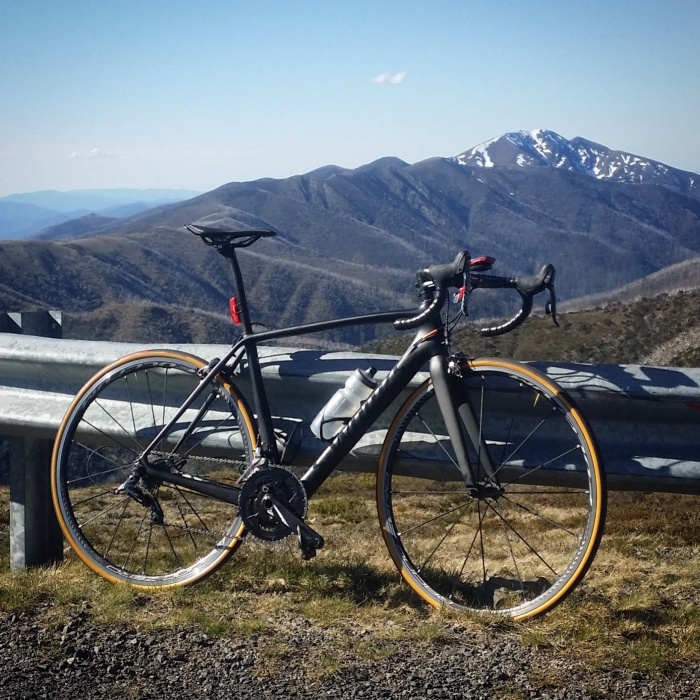
On Mt Hotham with Mt Feathertop in the distance. November 2016
In the wild
Sometimes, I gaze at this bike and think it’s a work of art. But they say works of art aren’t finished so much as abandoned and I wasn’t quite ready to abandon the honing of this build.
The first change I made was a step backwards from the boutique to the practical, and this actually preceded the Tour of Bright. I’d been descending a stretch of road between Reefton Spur and the Lake Mountain summit turn-off, heading west. I didn’t realise, but my back tyre was slowly deflating. I’d never noticed a puncture, nothing felt awry. But as I leaned into a corner at about 50kph, my tyre rolled on the rim. The bike went sideways. I had just enough time to think ‘I’m gone’ … but then I wasn’t. The bike slid out one way then the other. I was upright, in disbelief, and brought the bike to a sudden stop.
I swapped out the deflated latex tube for the butyl spare I was carrying and immediately noticed the difference. I don’t really understand how tubes affect rolling resistance – you’re rolling on the tyre. Vittoria butyl tubes are only 93 grams but the bike felt immediately sluggish. Later I read that if you’re doing a lot of mountain descending and braking latex tubes might not be the best idea. So I switched back to butyl, gaining 86 grams across the bike, losing some speed, but gaining some piece of mind.
Soon after the Tour my S-Works stem arrived. To be honest I couldn’t tell the difference except the new stem was glossy which I didn’t like as much, but it was nice to have a complete S-works cockpit.
The next change I made was to the new Dura Ace 9100 pedals when they became available. Here’s a weight comparison to the Ultegra,
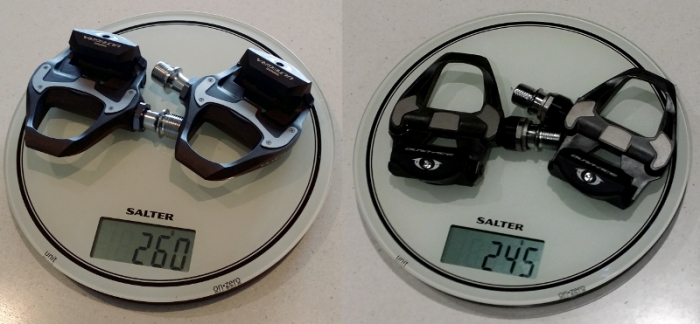
What’s 15g worth to you?
I go though pedals too quickly, specifically non drive side pedals. That’s the side I unclip from and my commute has a lot of traffic lights! I should get a cheap pedal for the non drive side, just for commuting!
In Adelaide, spectating the 2017 Tour Down Under, I started having some shifting issues. I took the bike into the Specialized pop-up shop and they noticed the bb adapter cups were working out of the frame a bit. I didn’t understand why crank torque wouldn’t keep them in, but either way after a whack with a mallet the cups were back in and I was off again.

A break by the sea. Adelaide January 2017.
But for months afterwards I endured chain ring shifting issues. I was getting uncommanded downshifts to the smaller chain ring which seemed to be triggered by shifts on the rear derailleur to smaller cassette sprockets. This would often happen after I crested a hill whilst cross-chaining. If I was quick I could catch the shift, but if I hesitated the chain would invariably drop. It was annoying to often hear the response that I shouldn’t be cross chaining when I was sure the uncommanded shifts were not the result of bad technique.
In France I went back to the old Falcon Grey chain ring to see if my newer black chain ring was at fault.
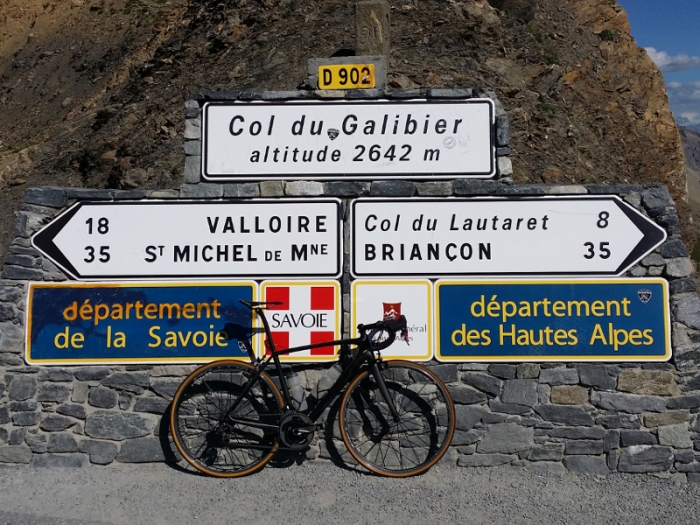
Galibier!
The issue seemed improved, momentarily, but then it began to assert itself as often as before.
Back in Australia I looked long and hard at the whole drive train. I became convinced the adapter cups never inserted perfectly flush with the frame and this was causing a minute chain line issue. I ordered a Praxisworks BB adapter which runs all the way through the BB shell. My hypothesis was met with some scepticism, but sure enough the problem was finally solved. Finally, after the best part of a year the bike was shifting beautifully on every ride.
Final Changes
A final burst of upgraditis brought the build to a conclusion before the ill-fated 2017 Tour of Bright. I was determined to get the bike to 6.8kg, including the rear light. Article 1.3.019 of the UCI’s Clarification Guide of the UCI Technical Regulations states:
The minimum weight of the bicycle (in working order) is 6.800 kg, considered without on-board accessories in place, that is to say those items that may be removed during the event. The bottles, on-board computers and GPS systems must be removed during the weight check. However, the bottle cages, fixture systems and clipped-on extensions are part of the bicycle and stay in place during the weighing.
In Australia, it is a requirement to race with a rear light when on open roads. Since it would be illegal to race without, it needs to be considered a fixed part of the bike contributing to its accepted weight. So I made my rear light lighter, replacing my 30g French Cateye X with a 19g Australian Knog Mini. I sometimes think for club racing we should include the 100-200g of bidons we carry – It’s not like we can legally toss them aside!
I realised the 24mm/26mm Specialized tyre speed finding was pretty good marketing which stopped tyre rotation (buying one at a time, replacing worn out rear with previous front)! So I went to 24mm front and back and saved another 29 grams:
Quietly (my faster half had said not to) … I went back to latex tubes. This time to Challenge. They’re a little heavier than the Vredestein but feel much sturdier:
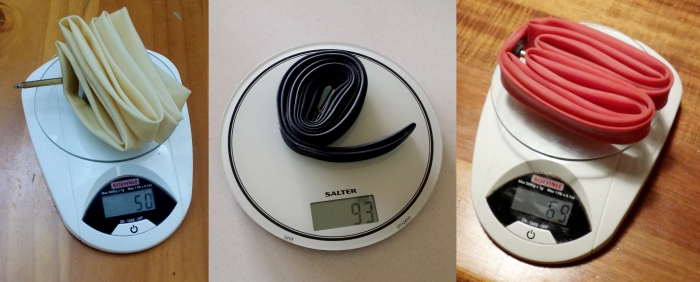
From left to right: Vredestein latex 50g, Vittoria butyl 93g, Challenge latex 69g.
Then I did something slightly absurd. I did this:
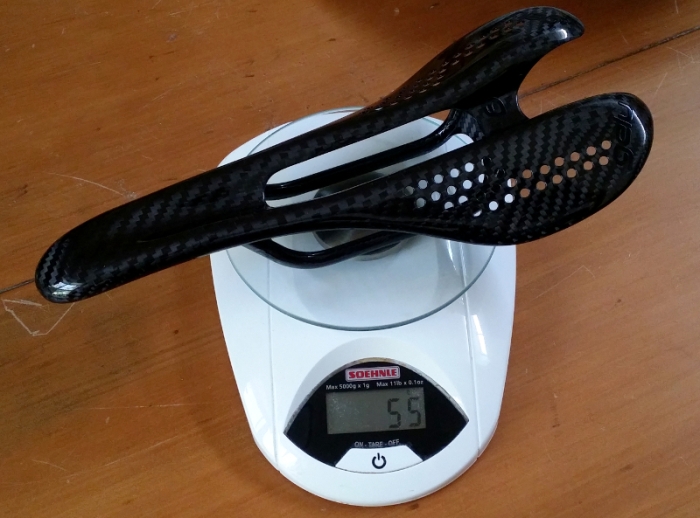
122mm Gelu G3 55g
This might be weight-weenieism gone mad. But the GELU 3 instantly shaved the best part of 100g off the old (and more comfortable) Bontrager Paradigm XXX. ‘Not an endurance saddle!’ a friend observed. Well, I survived 200km on it yesterday but I’d be lying if I said there weren’t a few moments I wished I had the Bontrager to plonk into.
So this was the end of the build, in a way. But not what I could race on:
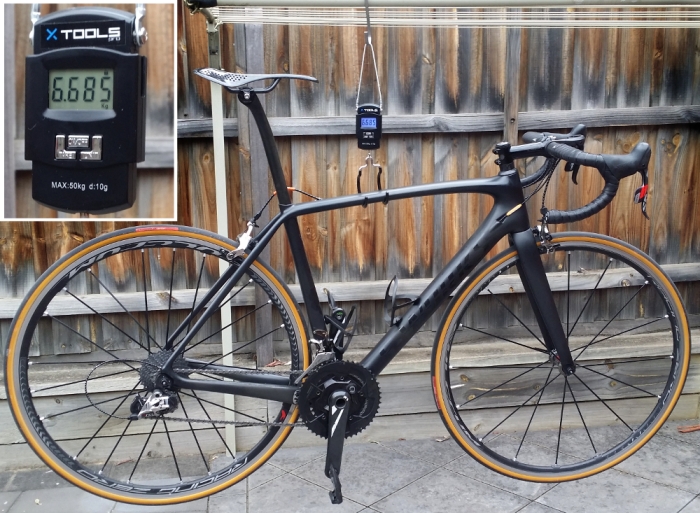
Final weight: 6.685kg
Now I’d gone too far in the other direction! The easiest solution for racing is to swap back the Bontrager saddle. With the light, it puts me pretty much bang on 6.8kg. Until the UCI changes the rules …
For the record – I made the Roubaix, which I commute and often train on, heavier. It’s over 8kg with slow 28mm commuting tyres, and my next build post will be heavier still. So I’m not a die-hard weight-weenie but I do agree with the old adage: ‘train heavy – race light.’
Sometimes though, it’s fun just to relish your good bike and tear about :)

Having a blast on my birthday. November 2017.
Component list November 2016 – December 2017 (weights to be completed):
| Component | Details | Weight |
| Frame | 2017 S-Works Tarmac 54cm with S-Works Seat post | ~ 1.3kg |
| Wheelset | 2015 Fulcrum Zero | ~ 1495g |
| Powermeter | Quarq Riken R GXP | ~ 805g (including chainrings, excluding pedals) |
| BB Adapter | Specialized adapter cups (November 2016 – October 2017) | 116g |
| BB Adapter | Praxisworks Isis2 | 116g |
| Shifters | SRAM Red 22 | |
| Rear Derailleur | SRAM Red Short cage RD | |
| Rear Derailleur | Long Cage Red RD for Mt Baw Baw Road Race (May 2017 only) | |
| Front Derailleur | SRAM Red 22 | |
| Brakes | SRAM Red Aerolink | |
| Bars | Specialized Comp Alloy shallow bend 40cm (November 2016) | |
| Bars | S-Works Carbon shallow bend 40cm | 190g |
| Stem | Specialized Comp Alloy (November 2016) | |
| Stem | S-Works110mm | |
| Bidon holders | Wasserträger 2.0 (+ 2x 0.75L bidons) | 9g |
| Cables | Alligator iLink | |
| Saddle | Bontrager paradigm XXX 128mm (November 2016 – November 2017) | 144g |
| Saddle | Gelu G3 122mm | 55g |
| Pedals | Ultegra (November 2016 – March 2017) | 260g |
| Pedals | Dura Ace | 245g |
| Tyres | S-Works Turbo Cotton 24mm Front / 26mm Rear (24mm x2 from December 2017) | 209g / 238g |
| Tubes | Vredestein Latex Road Tube (November 2016) | 50g |
| Tubes | Vittora Butyl (December 2016 – November 2017) | 93g |
| Tubes | Challenge Latex | 69g |
| Chain | Duraace 11 Speed (November 2016 – August 2017, December 2017 – ) | |
| Chain | SRAM Red 22 (August-November 2017) | |
| Chain Rings | SRAM Red 50/34 Falcon Grey (November 2016, July 2017) | |
| Chain Rings | SRAM Red 50/34 Black | |
| Cassette | Ultegra 11-28 (November 2016 – March 2017) | 246g |
| Cassette | Duraace 11-28 (March – August 2017, December 2017 – ) | |
| Cassette | Ultegra 11-32 Mt Baw Baw Road Race (May 2017) | |
| Cassette | Sram Red XG1190 11-28 (August – November 2017) | 167g |
| Skewers | Planet X Titanium | 20g / 23g |
| Bartape | Lizard Skins DSP Race | |
| Garmin Mount | SRAM | 19g |
| Computer | Garmin Edge 500 (November 2016) | 58g |
| Computer | Garmin Edge 520 | 64g |
| Rear light | Cateye X (November 2016 – November 2017) | 33g |
| Rear light | Knog mini | 19g |



Awesome build! I’m currently on a mission to get my alloy framed Kinesis as light as I can (without spending too crazy). I recon I can get to low 7’s. We shall see. How do you find those Turbo Cotton tyres? I’ve got the regular S-Works Turbo 24mm tyres on my Rovals, they seem fast and light without being too fragile.
Thanks! The tan-wall Turbo Cotton are stocked here in Melbourne by Specialized shops. Bike Ride in Hobart might have them? (just checked your blog and saw you’re in Tassie). It is possible to get a non-carbon bike under 7kg. Like this: https://2lo8.wordpress.com/my-non-carbon-bike-6-7kg/ but that guy has a very light non-carbon frame.
Wow there’s some serious compromises in the name of lightweight there! Not sure I’m quite that serious, haha! Thanks for the info.
200km on a carbon saddle. You are mad!
I have an Emonda btw Alain…not sure about the aero characteristics but I can report it is unbelievably comfortable. Not just geometry wise but Trek have done an amazing job in eliminating vibration. It was my choice on the trip to Cairns because of the comfort.
I think they’re beautiful bikes George, and I might have bought an SLR frame if I could have. But when you’re planning to spend large amounts of money little things start to niggle. That blog post and my inability to get a frame was enough to dissuade me. But Alberto put the sword to the best riders in the world at the Vuelta on an Emonda. For a rider like me to quibble is silly I know!
Do you still have the G3?
Hi Howard, I still use the G3. Though I alternate with my Bontrager saddle as it’s not the most comfortable thing in the world!